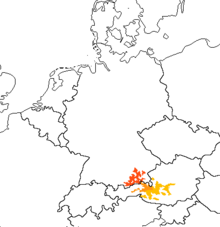Alpian languages
| Alpian languages | |
|---|---|
| dà Alwedülg | |
| Created by | Raistas |
| Setting | parallel Earth |
| Native to | Austria and Germany |
| Ethnicity | Baaye (Baaye chen) and Vaand (Vään schen) peoples |
| Native speakers | 310 000 (2012–2016) |
Oronaic
| |
Early form | Proto-Alpian
|
| Official status | |
Official language in | Austria (Salzburg and Carinthia); Germany (Upper Bavaria. |
Distribution of the Alpian languages:
Baaye
Northern Vaand (Fölvaand)
Vaand | |
The Alpian languages are spoken in the area of the Alps, in Austria and Bavaria, by approximately 310,000 people altogether. They derive from a common ancestral language called Proto-Alpian, and form a branch of the Oronaic language family. The branch consists of two living languages: Baaye and Vaand, which share a fair amount of mutual intelligibility between each other.
Classification
The languages are traditionally divided into Western and South-Eastern groups, which are geographic rather than genealogical groupings.
- Western (areal)
- †West Alpian (Schawardülg)
- Central Alpian
- Baaye
- Vaand
- Northern Vaand (Fölvaand)
- †Southern Vaand (Halvaand)
- Eastern Vaand (Edevaand)
- South-Eastern (areal)
- †Estric
- †Esterixic
- †Noroeic
Genealogically Western branch diverged first with a common sound change (*ï>*a, *e>*ä merge and raise of *ë to a new *ï) while *ë,ï>i merge is established for Noroeic. West Alpian is known only by placenames, since it left no written records and went extinct in the VIth century AD; it was more closely related to modern Alpian languages, than to the South-Eastern branch. Esterixic could have been a dialect of Estric or it was a different name for the same language, and very little is known about these two. Some scholars believe Esterixic to have been an ancient Carpathian language or an intermediate language between the Alpian and the Carpathian branches. On the other hand, some sentences were documented in Noroeic during the Ist and IInd centuries CE and point to the language belonged to the Alpian languages, possibly related to Estric.
Origins
There are two main hypotheses concerning the origin of the Alpian language group: a direct descendance from Proto-Oronaic and the Alpathian hypothesis that claims a connection between the Alpian and the Carpathian branches. A hypothetical Common Alpian language was spoken in the Central Europe, specifically in the territiory of modern Austria and the Czech Republic around the III milleania BCE and moved to the modern area due to the Indo-Europeans migration. Western branch split from other ancient languages around the I millenium BCE but probably had remained mutually intelligible by the time of the Roman Empire. The Estric language had already been in decline, replaced by Celtic and Germanic languages afterwards with Noroeic becoming excinct a few centuries later.
Baaye and Vaand became separate in the XVIth century and developed from different dialects of the Old Alpian language, which was attested in some inscriptions on pottery meant for trade. Baaye and Vaand (with Fölvaand sometimes included as a separate language) are the only living languages of the Alpian group.
Features
As the other Oronaic languages the Alpian branch has reduced its vowel harmony, but still keeps it in most grammatical endings and suffixes. A prominent feature of most Alpian vowels is ablaut: a vowel in a word stem turns into different vowel under a certain environment.
Alpian nouns have only four true cases and two numbers. Vaand also has case clitics, that do not act like true case endings in this language. Both Baaye and Vaand have a definite article (de in Baaye and dà in Vaand) and an indefintite or collective article chen or schen depending on a preceding sound. Verbs agree not only with the subject of a sentence, like in English and German, but with a direct object (if the verb is transitive). Noroeic also had an indirect object agreement but it disappeared in modern languages. It is called the polypersonal agreement and can be found in Basque, some Caucasian languages, Hungarian, and Maltese (all non-Indo-European). The traces of it can be found in modern Carpathian languages. Ancient Alpian languages were all active-stative. Modern Baaye and Vaand are mostly nominative-accusative like German, but they show ergativity in the perfect tense.
Through contact with neighbouring peoples, Alpian languages have adopted many words from old Celtic languages (specifically Noric), Latin, and German, among other languages. There is a considerable number of Celtic and Latin loans, for example: föllör ("flower", from Latin florem), marsch ("horse", from Celtic marcos), eutz/eitz ("age", from Celtic aesus), keimme ("exchange" from Celtic cambios), koosche ("thing", from Latin causa).
